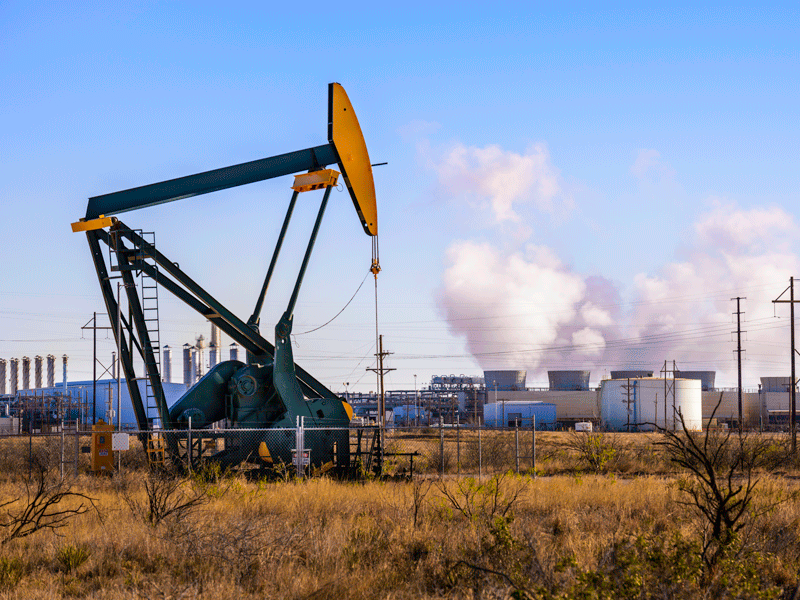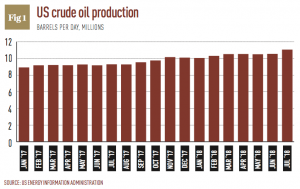Poor infrastructure is threatening to derail the US shale boom
US shale output
continues to soar in the Permian basin, but worries about poor infrastructure
hampering production won’t go away

The huge amounts of oil and gas that are being
extracted from the Permian Basin are causing frustrating bottle necks for
producers in the region
This July, the US crude
oil industry celebrated a groundbreaking moment when its output
averaged an estimated 11 million barrels per day (BPD) for the first time ever
(see Fig 1). This makes the US the world’s second-largest producer,
behind only Russia. The surge is largely down to the boom in shale oil and gas
production in the Permian Basin across the west of Texas and south-east New
Mexico. Drilling in the region began to ramp up a decade ago, and it is only projected
to continue growing. But there is one hurdle standing in the way: a lack of
critical infrastructure.
It is not just oil
pipelines that are unable to keep up with demand – the associated natural gas
production has also overwhelmed the system
In recent months,
producers have experienced pipeline bottlenecks due to the vast amounts of oil
and gas being pumped out of the Permian Basin, where output has reached around
3.4 million BPD. With the current pipeline capacity sitting at approximately
3.56 million BPD, analysts expect the constraints to begin limiting growth in
the region next year.
Growing pains
before the rapid development of America’s shale industry caused a new surge in crude output; US oil production peaked at about 9.6 million BPD in 1970. After that, it decreased steadily, falling as low as five million BPD in 2008. Around this time, however, producers revolutionized the industry by using hydraulic fracturing, or fracking, and horizontal drilling to extract oil and gas trapped in reservoir rocks. Production soared at the fastest pace in the country’s history, upending the global oil and gas industry.
before the rapid development of America’s shale industry caused a new surge in crude output; US oil production peaked at about 9.6 million BPD in 1970. After that, it decreased steadily, falling as low as five million BPD in 2008. Around this time, however, producers revolutionized the industry by using hydraulic fracturing, or fracking, and horizontal drilling to extract oil and gas trapped in reservoir rocks. Production soared at the fastest pace in the country’s history, upending the global oil and gas industry.

The Permian Basin is at
the center of the US shale boom. It is one of the world’s thickest deposits of
rocks from the Permian geologic period, and along with the legendary Ghawar
Field in Saudi Arabia, the Permian is one of the worlds most prolific. Since
2012, production there has grown by about two million BPD, which is more than
any other field.
It is estimated that
another 75 billion barrels of recoverable oil lie within the Permian. Brian
Collins, a senior researcher at S&P Global Market Intelligence, told World
Finance that this basin will be the “mainstay for US production for
the foreseeable future”.
Its success, however, is
beginning to highlight cracks in the area’s infrastructure. By the end of 2018,
BP Capital Fund Advisors expects production to exceed available pipeline space
by 300,000 to 400,000 BPD. By 2019, that gap will rise to 750,000 BPD, causing
a “significant” amount of oil to be stranded in the basin.
And it is not just oil
pipelines that are unable to keep up with demand – the associated natural gas
production has also overwhelmed the system, and the accompanying water that is
produced is becoming a problem too. For every barrel of oil produced, between
three and five barrels of contaminated water must also be piped away.
Additionally, more pipelines will soon be needed to handle natural gas liquids,
which are components of natural gas.
“So we’ve got basically
four different infrastructure systems that are extremely challenged right now.
This basin is not going to stop growing, either. It’s going to keep growing as
these companies expand across it,” Collins said.
Shifting away
as news came to light in May that pipeline bottlenecks were constraining crude shipments, the share prices of companies based in the region started to slide. At the beginning of June, Bloomberg reported that eight of the basin’s pure-play drillers had lost $15.6bn in combined market value in just two weeks – or around $1bn a day.
as news came to light in May that pipeline bottlenecks were constraining crude shipments, the share prices of companies based in the region started to slide. At the beginning of June, Bloomberg reported that eight of the basin’s pure-play drillers had lost $15.6bn in combined market value in just two weeks – or around $1bn a day.
2 million
The growth in BPD
production in the Permian Basin since 2012
3.4 million
The BPD production
capacity in the Permian Basin
3.56 million
The BPD capacity of
pipelines in the Permian Basin
What’s more, oil
behemoth BP recently revealed its oil trading unit had swung to a quarterly
loss due to the Permian bottlenecks, which have led producers in the region to
sell their crude at a hefty discount relative to benchmark West Texas
Intermediate prices. While the spread was as little as 40 cents at the
beginning of the year, it reached between $15 and $20 a barrel in August. This
discount is expected to persist for at least another year.
Not only are producers
grappling with discounts on their oil, but in response to the squeeze companies
have also been forced to go down the expensive route of storing their crude or
driving it hundreds of miles on trucks to pipelines in other parts of the
state.
Because of this,
ConocoPhillips – one of the top oil producers in the US – revealed in June that
it would temporarily redeploy resources out of the Permian Basin. “We have
other opportunities to go spend our capital,” CEO Ryan Lance told the Financial
Times. “And I am not sure it makes sense to drill into that headwind.” A
number of other companies both big and small are beginning to “shift their
emphasis to other basins”, Collins said.
But while oil and gas
firms with deep pockets can wait around for returns on their investments, the
midstream companies that build the desperately needed infrastructure cannot
make investments into pipelines without knowing if they will receive a steady
volume of oil or gas.
“An issue right now is a
lot of the natural gas pipelines that are needed are having a hard time getting
off the ground because producers are not necessarily used to having to pay
somebody to build them a pipeline to get rid of their gas,” Collins said. Even
one of the largest pipeline builders in the US, Kinder Morgan, is conservative
about the prospect of building new pipelines.
The big fix
According to BP Capital, “meaningful relief” is set to come to the Permian in the second half of 2019 with the set-up of key long-haul pipelines, such as EPIC, Gray Oak and Cactus II. The International Energy Agency (IEA) said TexStar Midstream Logistics’ EPIC pipeline – one of the biggest and most advanced projects in development – “holds the key to solving pipeline bottlenecks in 2019”.
According to BP Capital, “meaningful relief” is set to come to the Permian in the second half of 2019 with the set-up of key long-haul pipelines, such as EPIC, Gray Oak and Cactus II. The International Energy Agency (IEA) said TexStar Midstream Logistics’ EPIC pipeline – one of the biggest and most advanced projects in development – “holds the key to solving pipeline bottlenecks in 2019”.
The pipeline was
originally set to carry 440,000 BPD, but it could be upgraded to transport
675,000 BPD due to high demand. Once these pipelines are in place, crude oil
produced in the region is expected to stop selling at a discount compared with
benchmark prices.
In BP Capital’s view,
the sell-off in the region’s exploration and production firms was “overly
severe and particularly short sighted”. The firm stressed in an online article
that the bottlenecks are a “relatively short-term issue that does not diminish
the long-term attractiveness and potential of the Permian Basin”.
While it is true the
basin remains attractive for many producers, the IEA expects output to grow at
a slower rate in 2019 as pipeline capacity remains tight. The Paris-based
agency predicted output would rise by 1.3 million BPD this year and just
900,000 BPD in 2019. According to the IEA: “Pressure on midstream
infrastructure and pipeline capacity out of the Permian and Eagle Ford basins
in Texas is unlikely to be resolved before the second half of 2019. Labor
shortages, road congestion and water disposal constraints could also contribute
to curbs in expansion in the short term.”
There are additional
concerns that the pipeline projects could face delays. Analysts at Morgan
Stanley expect slowdowns of three to six months for some projects due to the
complexity of the proposed lines. This could lead to the production of just
360,000 BPD in the Permian Basin in 2019, Morgan Stanley said. Some midstream
companies also face higher-than-expected material costs because of President
Donald Trump’s 25 percent tariff on steel imports. For Plains All American
Pipeline, which is building the 585,000-BPD Cactus II pipeline, the tariff has
increased the cost of its $1.1bn pipeline by about $40m.
However, it is unlikely
the basin’s problems will end in 2019. Production is expected to continue
ramping up in the region in the decades to come, and the planning process for
building pipelines appears to be flawed. Collins said a new type of financing
would be needed to allow producers to better cooperate with midstream players:
“If oil and gas companies actually formally commit and sign on to be a shipper
on a pipeline, that’s how these pipelines will get built.” Yet, Collins
admitted, most producers are reluctant to own their own pipeline.
Therefore, the ‘Wild
West’ environment is expected to continue. Collins said: “It seems like it’s
just going to be this odd situation where we’re going to get these pipelines
all built [and,] say two years from now, we have brought the pipeline space up
to where it can handle all of the natural gas and the liquid output. But then I
think that producers are going to continue to race along, and maybe this is
going to be a backwards-and-forwards kind of situation for many years.”
Although the new pipeline
projects face some potential hiccups, the current bottlenecks in the Permian
Basin are indeed a short-term problem. But the industry should take it as a
warning that until a more cooperative process is formed between producers and
pipeline builders, this could be the first glimpse of an issue that could plague
the future of one of the world’s top shale basins.
Comments
Post a Comment